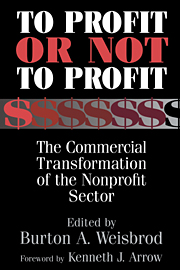Book contents
- Frontmatter
- Contents
- List of contributors
- Foreword by Kenneth J. Arrow
- Preface
- 1 The nonprofit mission and its financing: Growing links between nonprofits and the rest of the economy
- Part I Basic issues and perspective
- Part II Industry studies
- Part III Overview, conclusions, and public-policy issues
- Appendix: IRS Forms 990 and 990-T for nonprofit organizations
- References
- Index
Foreword by Kenneth J. Arrow
Published online by Cambridge University Press: 30 November 2009
- Frontmatter
- Contents
- List of contributors
- Foreword by Kenneth J. Arrow
- Preface
- 1 The nonprofit mission and its financing: Growing links between nonprofits and the rest of the economy
- Part I Basic issues and perspective
- Part II Industry studies
- Part III Overview, conclusions, and public-policy issues
- Appendix: IRS Forms 990 and 990-T for nonprofit organizations
- References
- Index
Summary
In every modern economy, no matter how strong the pledged and actual allegiance to the ideology of the market, there is a significant portion in which production is not governed by the maximization of profit and there are no legal claimants to any of the revenues. The decision-making entities in this nonprofit sector are, of course, operating in the context of a market economy. They have to purchase inputs on the market, and in many cases (e.g., hospitals, universities) they receive revenues from the users of their products. To finance the purchase of these inputs, they frequently receive, in addition to their user fees, donations. The government not only subsidizes these donations through tax laws but also frequently gives these nonprofits direct subsidies. Finally, nonprofit institutions profit from gifts of time from volunteer workers. Thus the resources that support the activities of nonprofits are received through a variety of channels: user fees, direct and indirect government subsidies, and donations of money and labor.
The role of nonprofit institutions in the United States is certainly considerable and worthy of study. Their revenues make up about 10 percent of the GNP, and they own roughly 10 percent of all property. Their special role, particularly their tax status, is justified on the grounds that they supply uniquely valuable services. However, the links between the commercial and nonprofit sectors are growing rapidly, and the lines that divide them are getting harder to define.
- Type
- Chapter
- Information
- To Profit or Not to ProfitThe Commercial Transformation of the Nonprofit Sector, pp. ix - xPublisher: Cambridge University PressPrint publication year: 1998



